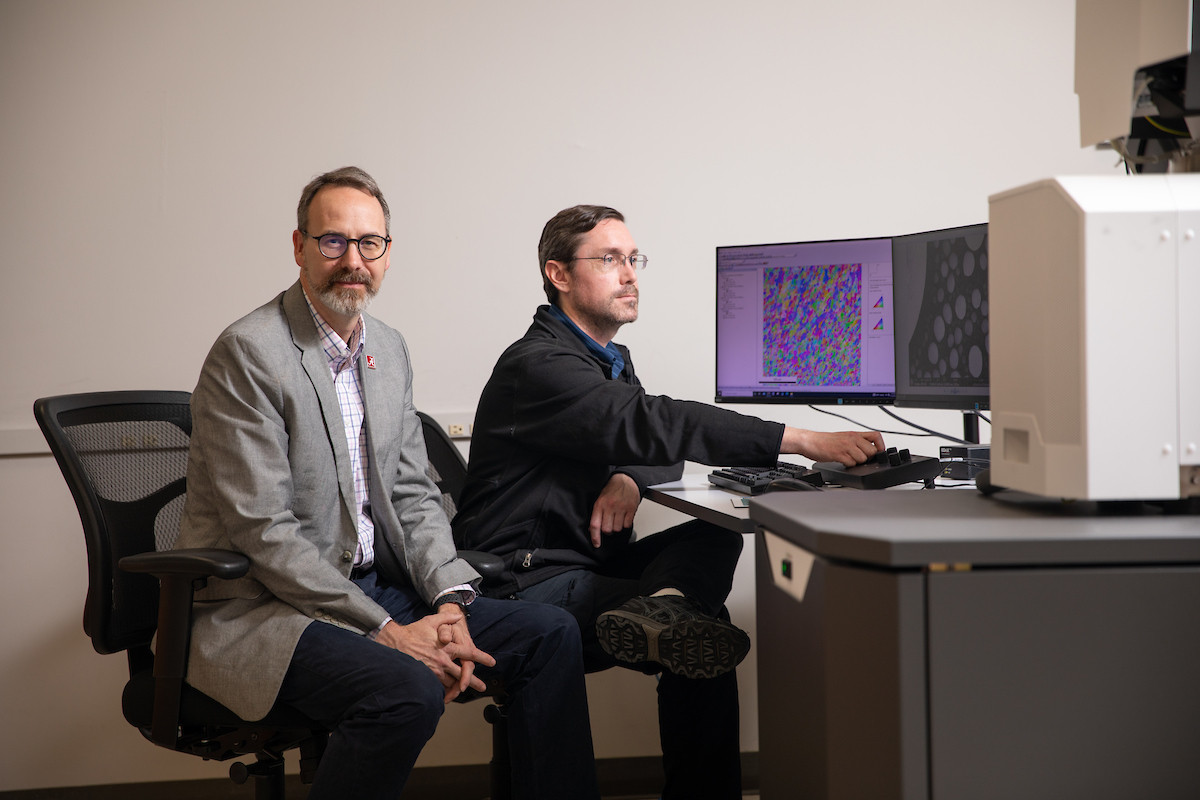
TUSCALOOSA, Ala. — A suite of new instruments focused on understanding materials will give The University of Alabama an elite platform to offer solutions to perplexing challenges while expanding opportunities for students to participate in cutting-edge research and enhanced classroom instruction.
The Board of Trustees of The University of Alabama recently approved upgrading equipment in the Alabama Analytical Research Center with a state-of-the-art atom probe, advanced imaging electron microscopes and focused ion beam based sample-preparation machines that build on UA’s established reputation at the forefront of materials characterization and analytical metrology.
The effort, part of a five-year strategic plan for research and economic development at UA, will usher in the next generation of materials education and research for energy, defense, transportation, human health and environmental sciences, boosting the development of a highly skilled workforce in the state.
“This renewal initiative of the instrumentation and infrastructure of the Alabama Analytical Research Center maintains the University’s preeminent leadership in education and research that support our state’s workforce needs,” said Dr. Russell J. Mumper, UA vice president for research and economic development. “The upgraded capabilities coupled with the expertise of our faculty and students will be an unmatched combination in the Southeast and nation.”
The AARC supported about $15 million in sponsored research in fiscal year 2022, part of a growing research enterprise at UA that is among the top doctoral research universities in the United States. These new instruments position AARC to be even more competitive.
Students and faculty from several engineering disciplines along with physics, chemistry and geology contribute to discovery in the AARC. In addition to users from campus and other universities, AARC has attracted researchers in several industries, including automotive, computing and aerospace, along with federal laboratories including NASA, Oak Ridge National Laboratory and those in the Department of Defense.
More than 150 students use the facility each year, and many trained on the instrumentation have gone on to work in advanced manufacturing industries with such companies as Intel, Apple, GE Global Research and Boeing as well as continuing their research at other institutions and national labs.
“This capability in AARC will be on par with a national lab core facility and will be a catalyst for innovative discoveries led by our faculty and students. This is a game changer for what will be accomplished by our users in the coming years” said Dr. Gregory Thompson, Distinguished University Research Professor for the UA System and director of the AARC. “Our students and faculty will have at their fingertips the most advanced electron, ion and X-ray measurement instruments in the world, placing our graduates with workforce skills to meet tomorrow’s challenges in critical national priorities.”
The instrumentation upgrade partners with Thermo Fisher Scientific, a global leader in servicing scientific discovery, on two electron microscopes and associated sophisticated machines that prepare material samples for imaging.
When the renewal project is completed in 2023, the AARC will house an aberration-corrected Spectra 300 (S)TEM providing direct imaging of atoms and chemical bonding environments that will be complemented by a Talos F200i TEM for defect imaging and micro-analysis. These electron microscopes are designed for studying a wide variety of samples and applications.

To go along with these two microscopes, UA is also acquiring two focused ion beam platforms, a Helios 5 Hydra CX DualBeam and a Helios 5 UX, which streamline preparation of high-quality samples of the materials and enable slice-and-view 3D reconstructions of material structures.
“This new suite of high-end electron microscopy solutions will enable the AARC to perform the most advanced 2D and 3D multiscale characterization across materials classes and industries. It is incredibly exciting to see the research that these new instruments will enable for UA,” said David Wall, vice president/general manager for Materials Science at Thermo Fisher Scientific.
Finally, a key upgrade linked with these instruments will be a new generation atom probe from CAMECA, a business unit of AMETEK Inc. and a leading global provider of electronic instruments and electromechanical devices as part of the AMETEK Materials Analysis Division. Atom probe tomography provides detailed 3D atom maps of a material with equal detection of all atom types with near-perfect rectification of their positions in a material.
The University is the first institution in North America to acquire the LEAP 6000 XR atom probe that inherits key features from previous generations of atom probes, adding deep UV laser pulsing to the proven local electrode design to deliver higher yield and data quality. Through compatibility with the microtip array and a redesigned optical system, the LEAP 6000 XR provides enhanced ease of use and the potential for fully automated operation.
This is the third time UA has updated a LEAP, which stands for Local Electron Atom Probe. In 2007, UA bought a LEAP 3000 to become the first academic institution in the Southeast — and only the third in the nation — to have the instrument on campus. In 2016, UA upgraded the atom probe and became the first academic institution in the Western Hemisphere to acquire a LEAP 5000.
“We are truly excited about The University of Alabama’s acquisition of our new LEAP 6000 XR,” said Jesse D. Olson, CAMECA business unit manager. “UA has considerable experience with APT, and we’re eager to see what they do with this new instrument’s capability. We’re certain that their research will result in many scientific breakthroughs in the near future.”
Contact
Adam Jones, UA Strategic Communications, 205-348-4328, adam.jones@ua.edu
